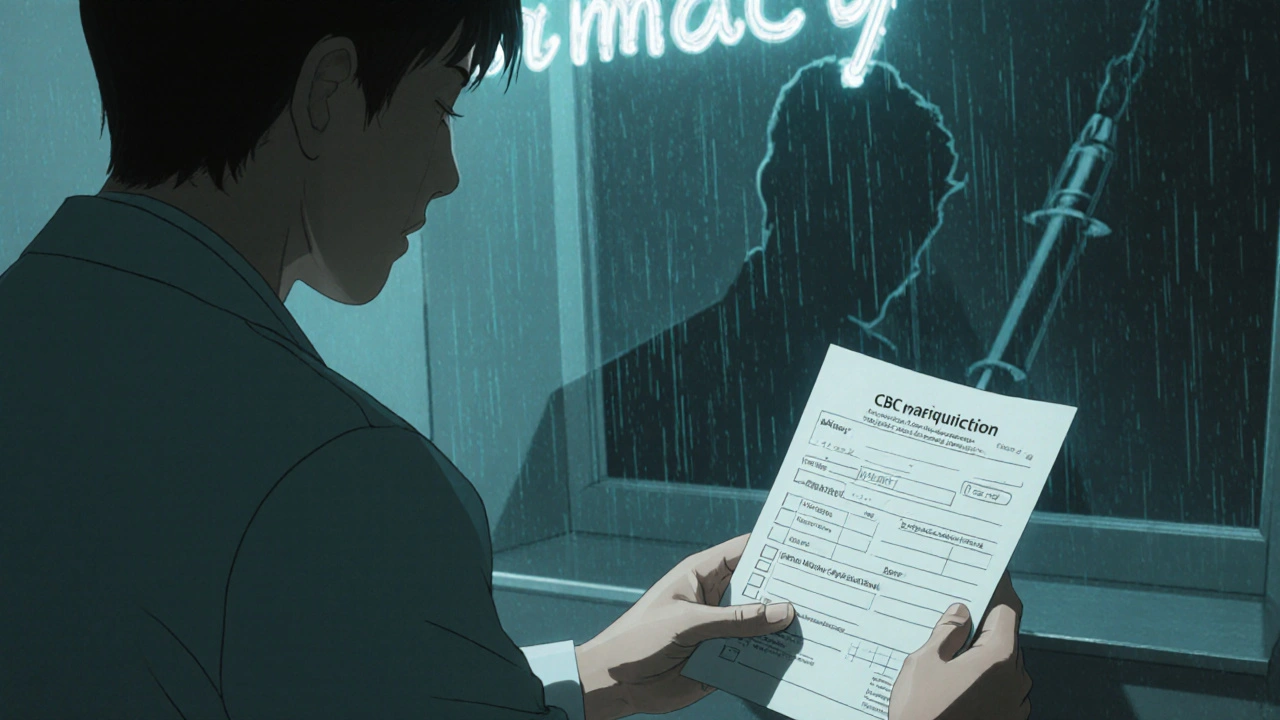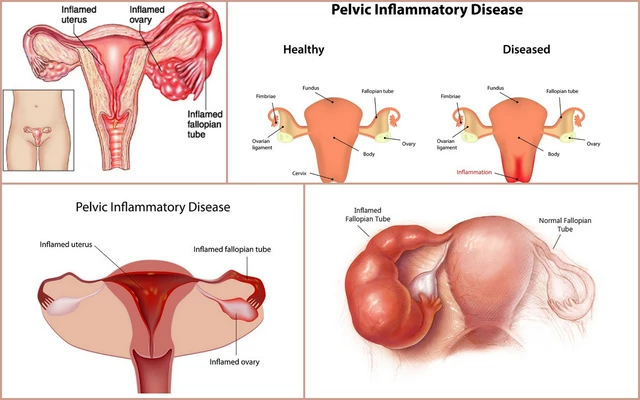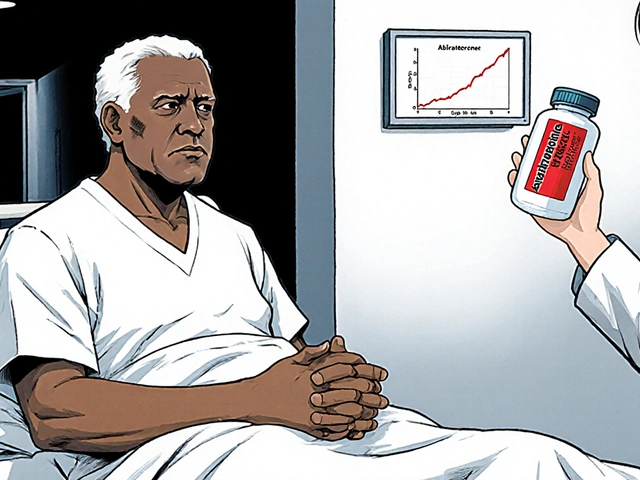Blood Count Risk Checker
Medication-Induced Aplastic Anemia Risk Assessment
This tool assesses your complete blood count (CBC) results against critical thresholds for medication-induced aplastic anemia. Based on Mayo Clinic guidelines, it helps determine if immediate medical attention is needed.
What Is Medication-Induced Aplastic Anemia?
Aplastic anemia is a rare but life-threatening condition where the bone marrow stops making enough red blood cells, white blood cells, and platelets. When it’s caused by medications, it’s called medication-induced aplastic anemia. Unlike normal side effects like nausea or dizziness, this isn’t just a temporary reaction-it’s damage to the stem cells that build your blood. Once these cells are destroyed, your body can’t replace them fast enough, leading to a dangerous drop in all three blood cell types. This is called pancytopenia.
It’s rare, but serious. About 5-10% of all acquired aplastic anemia cases come from drugs. Some medications, like chloramphenicol, can cause it in as many as 1 in every 24,000 people. Others, like carbamazepine, raise your risk by 15 times. The damage isn’t always obvious at first. You might feel tired for weeks and think it’s just stress or a virus. But if you’re taking a high-risk drug and your blood counts keep dropping, this could be the real cause.
Which Medications Are Most Likely to Cause It?
Not all drugs carry this risk. But some are well-documented culprits. The most dangerous include:
- Chloramphenicol - an old antibiotic rarely used today, but still linked to the highest risk. Even short courses can trigger bone marrow failure.
- Carbamazepine and phenytoin - anticonvulsants used for seizures and nerve pain. These don’t just suppress bone marrow; they can trick your immune system into attacking it.
- Sulfonamide antibiotics - like sulfamethoxazole (Bactrim), often prescribed for urinary tract infections.
- Gold compounds - once common for rheumatoid arthritis, now rarely used but still a known trigger.
- NSAIDs - especially long-term use of high-dose drugs like phenylbutazone or diclofenac.
- Certain antipsychotics - like clozapine, which requires regular blood monitoring for this very reason.
Chemotherapy drugs can also cause bone marrow suppression, but that’s usually expected and temporary. True aplastic anemia means your marrow doesn’t recover even after stopping the drug. That’s the red flag.
Early Signs You Can’t Afford to Ignore
The problem with medication-induced aplastic anemia is that it starts quietly. Most people dismiss the first signs. Here’s what to watch for-especially if you’ve been on one of these drugs for more than two weeks:
- Unrelenting fatigue - not just tired after work, but exhausted even after a full night’s sleep. This isn’t normal tiredness. It’s deep, bone-deep weariness.
- Unexplained bruising - purple marks on your legs or arms that appear without bumping into anything. Multiple bruises in one week? That’s not coincidence.
- Bleeding that won’t stop - nosebleeds that last more than 10 minutes, bleeding gums when brushing, or heavy periods when that’s not usual for you.
- Recurrent low-grade fevers - 99°F to 101°F that come and go, with no cough or sore throat. This means your white blood cells are too low to fight off small infections.
- Shortness of breath with mild activity - walking to the mailbox leaves you gasping. That’s your red blood cells dropping.
- Unexplained weight loss - losing 5-10 pounds over 2-3 weeks without trying.
These signs often appear 1-3 weeks before your blood tests show the problem. By the time you feel really sick, your counts may already be dangerously low. The key is catching it before you’re hospitalized.

What Happens If You Wait Too Long?
Delaying action is the biggest risk. Studies show survival rates drop sharply with time. If you’re diagnosed and treated within two weeks of symptoms starting, your chance of survival is under 10%. If you wait eight weeks or more, it jumps to 45%. Why? Because your body runs out of blood cells. Platelets below 10,000 mean you could bleed internally. Neutrophils below 500 mean you’re defenseless against bacteria-even a minor cold can turn into sepsis.
Patients often report their doctors first thought it was a virus, flu, or stress. One Reddit user described going to three different doctors over six weeks before someone finally ordered a CBC. By then, his platelets were at 8,000. He needed emergency transfusions and hospital isolation.
And here’s the worst part: if you restart the drug after recovery, there’s a 90% chance you’ll get it back-worse than before. That’s why stopping the medication immediately isn’t optional. It’s the first and most critical step.
What You Must Do Right Away
If you suspect medication-induced aplastic anemia, act fast. Here’s your urgent action plan:
- Stop the suspected medication immediately - don’t wait for a doctor’s note. Call your pharmacist or prescriber, but don’t delay. This is the single most important step.
- Get a CBC test within 24 hours - this is a simple blood test that checks your red cells, white cells, and platelets. If your hemoglobin is below 10 g/dL, neutrophils below 1,500/μL, or platelets below 150,000/μL, you need to see a hematologist now.
- Seek emergency care if you have a fever over 100.4°F - in aplastic anemia, fever is not a cold. It’s a medical emergency. Go to the ER. You may need antibiotics and isolation.
- Request a bone marrow biopsy if pancytopenia is confirmed - this is the only way to confirm aplastic anemia. It shows if your marrow is empty (hypocellular), which is the hallmark of the disease.
- Keep a full list of all medications - including supplements, herbal products, and over-the-counter drugs. Many cases are missed because patients forget to mention things like St. John’s Wort or high-dose aspirin.
Don’t wait for your next scheduled appointment. If you’re on a high-risk drug and have any of these symptoms, call your doctor today. If they dismiss you, go to urgent care. Ask for a CBC. Insist on it.

How Doctors Diagnose and Treat It
Diagnosis isn’t just about symptoms. It’s about numbers. The Mayo Clinic defines severe aplastic anemia as having two of these three criteria: reticulocyte count under 40,000/μL, neutrophils under 500/μL, or platelets under 20,000/μL. About 70% of medication-induced cases meet this definition.
Treatment depends on severity. For mild cases, stopping the drug alone can lead to recovery in 4-8 weeks. For severe cases, you’ll need:
- Immunosuppressive therapy - drugs like horse anti-thymocyte globulin (ATG) and cyclosporine. These calm your immune system so it stops attacking your bone marrow.
- Bone marrow transplant - the only cure for severe cases, especially in younger patients with a matched donor.
- Blood transfusions - to keep you alive while your marrow recovers. Platelets if you’re bleeding; red cells if you’re dizzy or short of breath.
New research is improving outcomes. A 2023 NIH trial showed a genetic test can identify drug-induced bone marrow failure within 48 hours with 92% accuracy. The AAMDS Foundation also launched a mobile app that helps patients track symptoms and blood counts, cutting diagnosis delays by 40%.
Prevention Is Possible
You can’t always avoid these drugs-they’re sometimes necessary. But you can reduce your risk:
- If you’re starting carbamazepine, chloramphenicol, or clozapine, ask for a baseline CBC before your first dose.
- Get a repeat CBC after one week, then again at two and four weeks.
- Ask your pharmacist: "Is this drug linked to bone marrow problems?" Pharmacists are often the first to spot the risk.
- Keep a written list of every medication you’ve ever taken. Share it with every new doctor.
- Know your family history. Some inherited bone marrow disorders can make you more vulnerable to drug toxicity.
Community clinics in rural areas struggle with access to quick testing, but if you live in a city, demand same-day blood work. Don’t settle for a "wait and see" approach. Your life depends on speed.
Final Thought: Your Body Is Trying to Tell You Something
Aplastic anemia doesn’t come out of nowhere. It whispers first-through fatigue, bruising, fever, and unexplained weakness. Most people ignore the whispers. By the time they scream, it’s too late. But if you listen early, you can stop it before it takes your life.
Medications save lives. But they can also break them-if we don’t pay attention. The science is clear: early detection saves lives. Don’t wait for a diagnosis. Be the one who asks the question before it’s too late.
Can a regular blood test detect medication-induced aplastic anemia?
Yes. A complete blood count (CBC) is the first and most important test. It measures red blood cells, white blood cells, and platelets. If all three are low (pancytopenia), it raises a red flag. But a CBC alone doesn’t confirm aplastic anemia-it just shows something’s wrong. A bone marrow biopsy is needed to see if the marrow is empty (hypocellular), which is the definitive sign.
How long after taking a drug does aplastic anemia start?
It usually develops between 2 and 8 weeks after starting the medication, but it can happen as early as 1 week or as late as 6 months. Some drugs, like chloramphenicol, cause symptoms faster. Others, like carbamazepine, may trigger an immune response that takes longer to build. If you’ve been on a high-risk drug for over two weeks and feel unusually tired or bruise easily, don’t wait-get tested.
Is medication-induced aplastic anemia reversible?
Yes, if caught early. In mild cases, stopping the drug alone allows the bone marrow to recover in 4-8 weeks. For severe cases, immunosuppressive therapy or a bone marrow transplant can restore function. But if you restart the drug, there’s a 90% chance it will come back-worse than before. Recovery is possible, but only if you act fast and never take the drug again.
Can over-the-counter drugs like ibuprofen cause aplastic anemia?
Rarely, but yes. High-dose, long-term use of NSAIDs like phenylbutazone or diclofenac has been linked to cases. Regular ibuprofen at standard doses (200-400 mg) is not a known cause. But if you’re taking high doses daily for months-especially with other risk factors-it’s worth discussing with your doctor. Never assume OTC means safe.
Should I stop my medication if I suspect aplastic anemia?
Yes, but do it safely. Don’t just quit cold turkey if you’re on something like carbamazepine for seizures-that can cause dangerous withdrawal. Call your doctor or pharmacist immediately. They can guide you on how to stop safely while you get tested. But don’t delay testing. The clock starts ticking the moment symptoms appear.
Can this happen to young, healthy people?
Absolutely. Aplastic anemia doesn’t care about age or fitness. Many cases occur in otherwise healthy adults and teens taking antibiotics or seizure meds. In fact, the median age at diagnosis is 30. Young people often get misdiagnosed because doctors assume they’re too healthy for something this serious. If your symptoms don’t fit a virus, push for a CBC.






Ankita Sinha
November 19, 2025 at 23:14
Just got my CBC back last week after weeks of feeling like a zombie-turns out my platelets were at 98k. I was on Bactrim for a UTI. My doctor blew it off as 'just low-normal,' but I insisted on a repeat. Two weeks later, they dropped to 62k. I stopped the antibiotic immediately and got referred to a hematologist. Thank god I didn’t wait. This post saved my life.